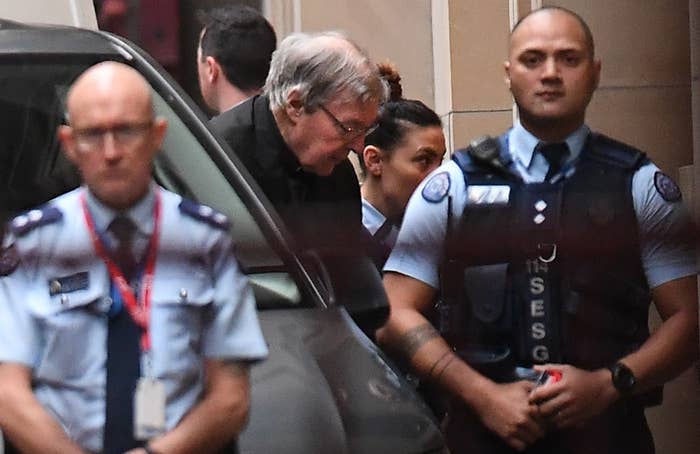
The jury who found George Pell guilty of sexually assaulting two choirboys must have harboured doubts about whether or not the cardinal was guilty, Pell’s lawyer has told an appeal court.
About 50 onlookers and more than 20 journalists from local and international outlets crowded into the Victorian Supreme Court in Melbourne on Wednesday morning, to hear the high profile appeal in which Pell, once an inner circle adviser to Pope Francis, fights his convictions.
His lawyer Bret Walker SC was on his feet the entire day, enumerating several issues — including the victim's story and evidence about church rituals — that he says show the offending was "impossible" and that the jury must have had a reasonable doubt about convicting the cardinal.
The complainants, who were both 13-year-old choirboys at St Patrick’s Cathedral in Melbourne at the time, cannot be identified and were referred to as J and R in the sentence.
J, now in his thirties, testified at trial last year, and R died in 2014.
J said that in Dec. 1996, Pell had discovered him and R drinking sacramental wine in the priest's sacristy — a dressing and preparation room for people involved in the church service — after Sunday mass. Pell pushed R's head down to his penis and held it there, and then orally raped J before touching J's genitals and masturbating at the same time.
Six weeks later, in February 1997, Pell indecently assaulted J by pushing him up against a wall and squeezing his testicles, as he walked through a corridor past the priest's sacristy.
A jury believed J, and found Pell guilty in Dec. 2018, making him the most senior Catholic in the world to be found guilty of child sexual abuse.
In court on Wednesday, Pell was dressed all in black and wearing his white clerical collar, which was noticeably absent when he was sentenced. He appeared to be intently following the proceedings and wrote on a yellow notepad as the hearing unfolded.

Walker told Chief Justice Anne Ferguson, President of the Court of Appeal Chris Maxwell and Justice Mark Weinberg that the jury must have doubted whether Pell was guilty.
He argued forcibly that the assaults had been demonstrated to be "literally impossible", that Pell's defence team had submitted "strong, credible and undispelled alibi evidence" and that the jury simply could not have excluded the possibility that Pell was innocent.
It was obvious the jury had believed J over Pell, but the matter did not end there, Walker said.
One of the issues with the story, Walker said, was that on J’s own account, the corridor assault happened in 1996, not 1997. This confusion over years is "not something that can be readily put to one side", Walker said.
Another major issue was location: Pell regularly mingled with congregants after mass, Walker said, placing him at a different part of the church than the sacristy at the time of the assaults.
"If he was at the western door during that time, then the law of physics tells us this is literally, logically impossible, for the offending to have occurred, according to the complainant's account, and there is no other account," he said.
"If I was in New Zealand, I was not in Australia for the offending alleged to have occurred in Australia."
The difference between the western door and the sacristy, Walker said, "suffices entirely for alibi purposes as would being across the Tasman".
He also cited the fact that there would have been other people present in the corridor — including the priest who delivered mass that day as Pell presided over the church ceremony — and that nobody had testified to seeing such an event.
Walker argued that the prosecution hadn't properly challenged witnesses over if and when the usual church procedures after mass — that crucially would have placed somebody else with Pell at the time of the offences — had been deviated from.
"You have to, in the jargon, destroy the alibi. Otherwise, there is reasonable doubt," he said.
Pell’s appeal overall puts forward "thirteen solid obstacles in the path of a conviction".
Walker was quizzed by Maxwell over whether the jury might have considered whether J was making it all up, and reasonably concluded he wasn’t.
"As a juror, [one] would ask the question, does this sound like an invented story?" Maxwell said.
He suggested a juror might think the story didn't show any signs of being untrue — for instance, someone making a story up wouldn't have suggested the corridor assault happened in such a public place.
Walker replied that this still wasn’t enough to remove a reasonable doubt.
"Honest people do get it wrong, honest people can give accounts that are less than convincing," he said.
"Honest people can give accounts, which they hear and they think more likely than not to be true and truthful, but not beyond reasonable doubt. That's my point."
Walker also pointed to evidence that R had denied being sexually abused when questioned by his mother, saying it raised a reasonable doubt.
"It’s impossible for that answer to be true and the complainant’s account of the first episode to also be true."
The prosecution is yet to argue its case in the appeal, but in written submissions filed to the court, Christopher Boyce QC wrote: “Sadly, an unwillingness by a victim of child sex abuse to disclose to those closest to him is all too familiar.”

Usually a jury would have the advantage of seeing a complainant testify in person, while appeal judges would only be able to read a transcript.
But in this case, Pell’s jury watched a video recording of the evidence J had given at the first trial, which miscarried after the jury could not agree on a verdict.
"The jury didn’t have the flesh and blood of the complainant," Walker said. "The jury had the same recording as you have."
Pell is also appealing the verdict on two grounds relating to how the trial was conducted.
Barrister Ruth Shann said a "substantial injustice" had been caused at trial when the defence was barred from showing an animation to the jury during its closing address that showed other people would have been in and around the sacristy at the time of the offences.
It was a "21st century" technology that would have assisted the jury in making sense of evidence from various witnesses about where they and others might have been at the time, against the "very simple and we say incomplete narrative" put by the prosecution, Shann said.
Before the hearing started, Ferguson briefly explained that she and the other two judges had read and viewed a large amount of material from the trial, including visiting the cathedral where the offences took place, and that the matters raised in court were only a small part of the evidence they would consider.
"When we ask a question, that does not mean we are particularly focusing on that issue, nor does it mean we take a particular view on that issue," she said.
"We are simply testing the argument."
The hearing continues.
